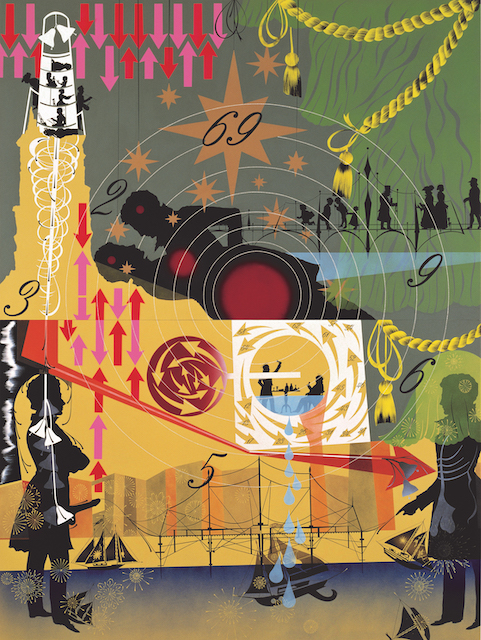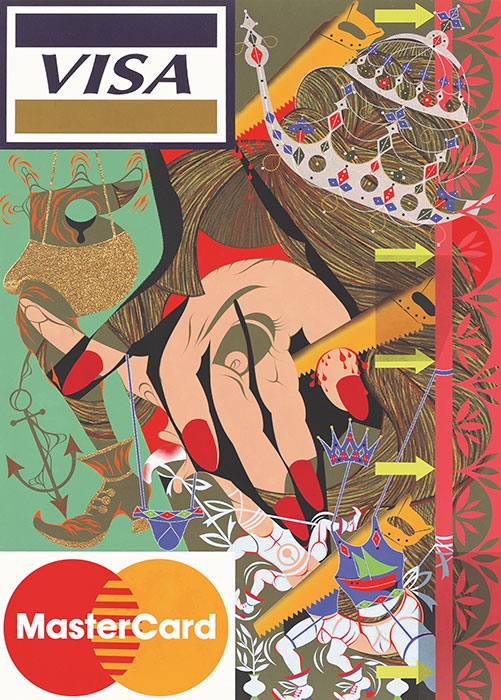How do you enter the world of Lari Pittman? Where do you start with paintings so dense with coded meaning that they resemble doublespeak bouncing off sound mirrors? Attune your sensibilities to a gay maximalism; prepare for visual and verbal platitudes transformed into bon mots; identify the verb and seek out the subject. Catch a phrase and you’ll catch the drift.
A tendency towards playfulness, ambiguity and idiosyncrasy can be traced through the Angeleno painter’s career. That reluctance to conform to easily identifiable categories means that his victories, too, have been hard won. As a student at the California Institute of the Arts during the mid-1970s, Pittman declined to be a part of the heteromacho Pictures Generation and instead looked to the legendary Feminist Art Program, brought to the school by Judy Chicago and Miriam Schapiro in 1971. When he started working, painting was dead; in 1985, Pittman himself almost died after being shot twice in the stomach by an intruder to his home. A turbulent period in American history – for a queer artist making queer paintings, the era of the AIDS epidemic and the Culture Wars was devastating – is encapsulated in motifs including coffins (in the Beloved and Despised series, 1989–90), guns and nooses. They seem to presage the rampant violence of American society today.

How Sweet the Day After This and That, Deep Sleep Is Truly Welcomed, 1988, acrylic, enamel, and five framed works on paper on wood, three panels, 244 × 488 cm. © the artist. Courtesy Regen Projects, Los Angeles
Yet seeking singular answers in any one of Pittman’s teeming paintings, let alone his body of work, is a fool’s errand and contrary to the work’s spirit. The purpose of this aesthetic and linguistic excess is to generate multiplicity of meaning. For example, This Wholesomeness, Beloved and Despised, Continues Regardless (1990) describes two sides of a furtive romance. Composed on double mahogany panels, the horizontal seam divides a realm in which the painting’s central characters, two men in silhouette, perform intimacy from another in which they perform indifference. A system of arrows, some turning widdershins and others colliding head on, discourage narrative linearity; rather, they imply a mixing of the private and the public to suggest the psychological complexity of closeted desire.
Pittman’s work is a declaration of independence from straight categorisation, drafted according to his own aesthetic values and influences
During a public conversation with Connie Butler, chief curator at Los Angeles’s Hammer Museum, on the occasion of Pittman’s recent retrospective Declaration of Independence, the artist fielded a question about the language of the objects – such as posies, gourds, cacti and crockery – that recur in his paintings. He replied that while the image might stay the same, its signification is variable. This notion, also applicable to semiotic play within the realms of gender and sexuality, is rooted in a queer wisdom that pays no heed to heteronormative conventions or canonical traditions. This isn’t to downplay the artist’s obvious dedication to the history of painting, but to highlight how he moved away from the established principles of painterly modernism to mine the relatively sidelined cultural histories of the decorative arts, textile design and craft. Pittman’s work is a declaration of independence from straight categorisation, drafted according to his own aesthetic values and influences.
His paintings are also haunted by the spectres of trauma. Intermingled with his customary flash and pomp, they lend the Needy series (1990–92) a peculiar shade of melancholy. The effect is not immediately apparent: Transfigurative and Needy (1991) is so vibrantly coloured and excessively ornamented that a viewer might easily miss the cartoon-faced, screaming houses on fire in the lower strata of the canvas or fail to grasp the symbolism of the inverted mauve owl that floats at the centre of the image, flanked by two burning candles. If the owl signifies wisdom, then an upside-down owl is a symbol of rebellious unlearning: in Transfigurative and Needy, all the clutter of Western thought is dumped into the flames of a burning bourgeois township. There goes the neighbourhood.

Pittman created the Needy series, in part, to counter the abundance of phallocentric art produced during the AIDS crisis (take for example Keith Haring’s The Great White Way, 1988) and, in another part, to acknowledge the vulnerability and resistance of a penetrable body. Owls are throughout the series outfitted with opulent vaginas but remain multigendered beings; the penis, when it does sneak into the image, as in Transubstantial and Needy (1991), is ghostly. Considered as such, the phrase ‘get out’ that hovers in close proximity to the orifices, especially in Transformational and Needy (1990), might be an exorcist’s command: patriarchy – get out! Hostility to nonbinary identity – get out! Legislation detrimental to the female body, the queer body – get out! And you, the viewer, are implored to get out of here, if you still can, by these birds that travel on the night-sea crossing.
Just as images are granted the mechanical function of words, so words are granted the privilege of pictorial form in Pittman’s oeuvre
Just as images are granted the mechanical function of words, so words are granted the privilege of pictorial form in Pittman’s oeuvre. That is, they get to be as fancy as everything else in the picture. A 1988 painting entitled How Sweet the Day After This and That, Deep Sleep Is Truly Welcomed is emblazoned with ‘!What?!’(perhaps a self-reflexive comment on the work’s verbose title) over two-thirds of its eight-by-sixteen-foot surface in a quasi-antique script described by Butler as a ‘raunchy italic’, also seen in the valediction ‘Sincerely, Lari’ unfurled across the centre of Spiritual and Needy (1991). In Untitled #16 (A Decorated Chronology of Insistence and Resignation) (1993) words slip into the image as credit-card logos, while works from the mid-1990s are peppered with the exclamations ‘HEY GIRL, LOVE-SEXI’ and ‘CUM ‘N’ GIT IT’ gussied up in a saloon-style typeface.
A 1991 artist book pits Pittman’s cacophonous visuals against novelist Dennis Cooper’s ultranaughty, handwritten prose in the semiepistolary Have you seen… An excerpt from Cooper’s contribution reads: ‘Carefully, Dennis stripped Lari’s clothes off. Canvas deck shoes, white socks, khaki short pants, t-shirt (ironed), vest. He folded and hid that away in the closet. Then he flipped Lari over and took a little sniff of his ass crack…’ The response on the page opposite shows one of Pittman’s iconic number 69s wedged between ‘Dear Dennis’ and ‘How do I find meaning?’ The question, of course, remains unanswered, but all the better for the blossoming of possibilities that conjecture allows.
Despite his claims to his works eschew the brutality of the outside world, they engage with the violence that now plagues the United States
Two decades after their collaboration, Cooper published The Marbled Swarm (2011), a novel tagged as ‘homosexuality fiction/murder fiction/cannibalism fiction’ in the Los Angeles Public Library catalogue. It is a tale set in a distinctly different world from Pittman’s, but the concept of ‘the marbled swarm’ – a densely allusive manner of speaking and writing that the narrator uses to beguile others – could fly across the divide into Untitled #5 (2010) or the drawings of Pittman’s Orangerie, an installation from the same period reprised in Declaration. (Remember, you must listen carefully to what you see.)
In his catalogue essay for the Hammer retrospective, Donatien Grau points out how Pittman, whose mother was Colombian and father American, uses his bilingualism to generate new hybrid forms of language and symbolism. In the paintings’ superficial elements, graphics and colour schemes alluding to the painter’s Latin American heritage are rolled together with iconography specific to white American kitsch. In This Wholesomeness, Beloved and Despised, Continues Regardless, for instance, note the pairing of colonial-era silhouettes with patches of the lime green, yellow, pink and red associated with fiesta.
Although Pittman claims, in conversation with Butler, that his works eschew the brutality of the outside world, they engage with the violence that now plagues the United States. In the monumental Flying Carpet with a Waning Moon Over a Violent Nation (2013), red-rimmed gun sights frame romantically Wild West terrain. That the landscapes within the circles are blurred reads as a comment on the shortsightedness of those firearms enthusiasts and policymakers who have failed to stop the hail of bullets in schools, movie theatres, concert venues, gay nightclubs and small-town holiday markets. But Pittman also draws a bead on the kind of citizens who allow this to continue; by situating the painting’s audience in a sniper’s stakeout, he implies that they too are implicated. The vaguely typographical forms of the drawing series New Map of America (2013), meanwhile, seem to propose an adjusted alphabet. No longer legible, the configurations are an open code: amoral, unfixed and available to be turned to any meaning. They cipher the difficulty of articulating these confused times.
From the January & February 2020 issue of ArtReview
